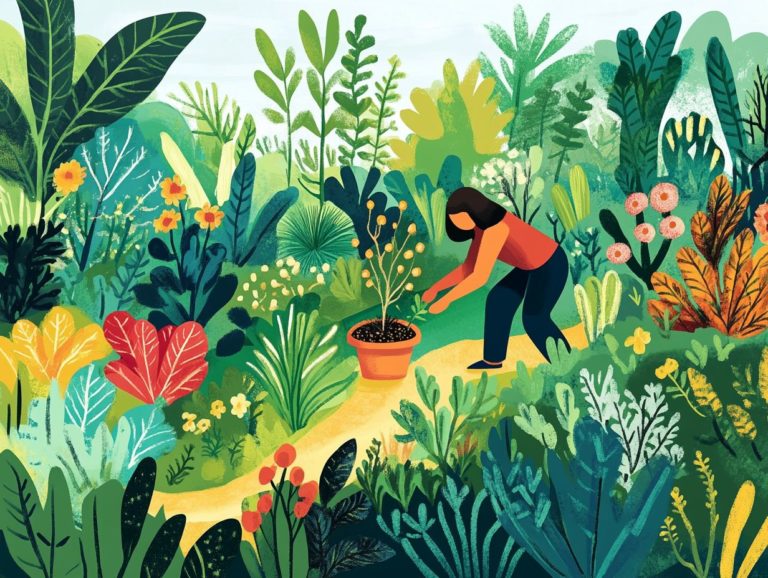How Does Companion Planting Benefit Your Garden?
Companion planting is an age-old gardening technique that pairs different plants together for their mutual benefit. This innovative method enhances soil health and boosts crop production. It also provides natural pest control, offering a holistic approach to gardening.
Delve into the rich history of companion planting and uncover its numerous advantages, including good combinations and bad combinations. You’ll find guidance on how to plan your own companion garden, along with strategies to sidestep common pitfalls.
Whether you re a seasoned gardener or just beginning your journey, this practice will supercharge your vegetable garden into a thriving ecosystem!
Contents
- Key Takeaways:
- What is Companion Planting?
- The Benefits of Companion Planting
- How to Plan a Companion Planting Garden
- Common Companion Planting Mistakes to Avoid
- Frequently Asked Questions
- What is companion planting and how does it benefit your garden?
- Want to know how companion planting can boost your soil quality?
- Can companion planting help with pest control?
- What are some companion planting combinations that work well together?
- How does companion planting benefit pollination?
- Is there scientific evidence to support the benefits of companion planting?
Key Takeaways:

- Companion planting involves planting different plants together for mutual benefit, maximizing space and crop interactions.
- It offers natural pest control, improved soil health, and increased yields, making it a sustainable and eco-friendly way to maintain an organic garden.
- When planning a companion planting garden, consider choosing complementary plants and designing the layout carefully to avoid common mistakes like overcrowding and pest damage due to planting incompatible plants together.
What is Companion Planting?
Companion planting is an innovative gardening technique that allows you to strategically position different plants close together. This enhances growth, maximizes crop production, deters pests, and fosters beneficial insects.
This method has deep roots in ancient agricultural practices, particularly among Native American tribes. They understood the mutual benefits of specific plant partnerships think of the classic trio of corn, beans, and squash, which exemplifies good combinations.
By grasping these relationships, you can cultivate a flourishing vegetable garden that promotes soil health, improves pollination, and maximizes space. This all adheres to an organic gardening ethos while using plants that improve soil nitrogen.
Definition and History
The concept of companion planting centers on growing diverse plants together in ways that benefit each other. This practice traces back to ancient agricultural systems, particularly those used by Native American tribes, which often highlighted valuable companion pairings.
These tribes had a deep understanding of the complex relationships among various crops, often employing methods like planting corn, beans, and squash together affectionately known as the ‘Three Sisters.’ This harmonious trio not only optimized space but also fostered vigorous growth. The tall corn provided a sturdy structure for the beans to climb, while the sprawling leaves of the squash sheltered the soil, suppressing weeds.
At the heart of companion planting lies the principle of natural pest deterrence. Certain plants can repel harmful insects or attract beneficial ones, enriching the ecosystem and improving health through biological control. Incorporating crop rotation into these practices helps prevent soil depletion and maintain increased biodiversity.
The Benefits of Companion Planting
Companion planting presents a wealth of benefits that can transform your gardening approach. From natural pest control and enhanced soil health to increased crop yields, understanding the benefits of using companion plants stands as a fundamental technique for sustainable agriculture.
Embracing this method can elevate your gardening experience and lead to thriving, vibrant plants, thanks to effective companion pairings and nitrogen fixers. Want to know how to boost your garden’s health? Start experimenting with companion planting today!
Natural Pest Control
Natural pest control is one of the standout benefits of companion planting. Certain plants can effectively repel pests or attract beneficial insects, creating a balanced ecosystem. This minimizes pest populations without harmful chemicals.
Take marigolds as an example. They’re celebrated for their ability to deter nematodes and other pesky insects while attracting pollinators. Similarly, buckwheat serves as a trap crop, enticing pests away from your more delicate plants. This clever tactic helps maintain a healthy garden space.
These strategies enhance natural pest control methods, ensuring your plants thrive in a nurturing environment. Living mulch, composed of low-growing plants, conserves moisture, suppresses weeds, and provides shelter for beneficial insects. This creates an unbeatable pest management strategy!
Improved Soil Health

Improved soil health is another compelling benefit of companion planting. Incorporate nitrogen-fixing plants—those that convert atmospheric nitrogen into a usable form—and cover crops to supercharge your soil’s nutrients and structure. To learn more about this technique, check out how to use companion planting for pest control.
Plants like clover and peas play a crucial role in enriching the soil. Their root systems contribute organic matter and improve soil structure through root exudates, setting the stage for thriving plants.
Boost soil fertility further by implementing practices like crop rotation, which prevents nutrient depletion and disrupts pest and disease cycles. These organic gardening techniques yield healthier plants and foster a balanced ecosystem that thrives on diversity and sustainability.
Increased Crop Yield
Increased crop yield is a remarkable outcome of implementing companion planting techniques. By strategically combining plants, you enhance growth rates and overall productivity through positive interactions.
Creating partnerships between different crops maximizes the available space and fosters beneficial relationships. For example, pairing tomatoes with basil an aromatic herb not only enhances flavor but also keeps pests at bay.
The combination of corn, beans, and squash often celebrated as the Three Sisters illustrates how diverse roles in crop interactions lead to a thriving garden ecosystem. Thoughtful crop combinations, like trap cropping, cultivate a more productive environment.
How to Plan a Companion Planting Garden
When planning a companion planting garden, choose your plants wisely. Consider which plants will thrive together and pay attention to their unique needs and interactions.
This thoughtful selection ensures that each plant contributes positively to the garden’s overall health and vitality.
Choosing Complementary Plants
Choosing complementary plants is essential in companion planting. Understanding effective combinations can significantly enhance growth. Avoiding harmful pairings helps your garden thrive and stay healthy.
By pairing plants thoughtfully, you can optimize nutrient availability and reduce the risk of pests. For instance, combining legumes with corn encourages nitrogen transfer, benefiting both plants. Avoid pairing tomatoes with potatoes; it can stunt growth due to shared diseases.
Similarly, onions and carrots make an excellent duo. Onions can deter pesky carrot flies, while carrots help aerate the soil for those bulbous roots. It s vital to consider factors like growth habits, water requirements, and shading.
Arranging plants wisely brings your garden to life! This careful orchestration leads to a healthier, more productive garden, thanks to effective weed control and pest management.
Layout and Design Considerations
When you set out to design a companion planting garden, layout is crucial for maximizing space. Each plant needs its ideal environment, potentially using living trellises for climbing varieties.
Creating an effective garden space involves employing various layout strategies. For instance, consider vertical gardening; it not only saves valuable ground space but also improves air circulation. This is particularly beneficial for your climbing plants.
Integrating living mulch can further improve soil structure and moisture retention. This creates a nurturing environment for robust root development, enhancing overall garden aesthetics.
Consider how visual barriers affect light and humidity. This allows you to cultivate a truly flourishing ecosystem that promotes increased biodiversity.
Common Companion Planting Mistakes to Avoid

Companion planting can elevate your garden’s productivity through effective crop combinations. However, common missteps can ruin your efforts.
For instance, overcrowding your plants or pairing species that do not coexist harmoniously can lead to increased pest damage.
Plants that Should Not Be Planted Together
In terms of companion planting, some plants don’t grow well together. Bad combinations can lead to increased pest damage and hinder growth. Understanding these intricate relationships improves your pest control strategies.
Tomatoes and basil are often celebrated as a dynamic duo. However, introduce corn into the mix, and you might find them competing for nutrients and water, which diminishes their vigor.
Similarly, planting cucumbers near aromatic herbs like sage can spell trouble. Those herbs release compounds that can stunt cucumber growth.
These poor pairings not only compromise the health of the plants involved but also create a welcoming environment for pests to thrive. Grasping these adverse interactions is essential for cultivating a thriving garden. It enables you to plan strategically, reducing pest populations and promoting healthier crop yields.
Don’t miss out on maximizing your garden’s potential!
Overcrowding and Other Common Errors
Overcrowding is a common mistake in companion planting. It can lower your garden’s output by causing fierce competition for resources.
When plants are crammed too close together, they vie for sunlight, water, and nutrients. This competition leads to stunted growth and reduced yields. Overcrowded plants create humid, stagnant conditions that allow pests to thrive. Additionally, soil health can decline as root systems compete for space and nutrients, negatively impacting fertility.
To avoid these pitfalls, adhere to proper spacing guidelines. Regularly assess plant health and consider using living mulch to optimize ground coverage while minimizing competition. Thoughtful planning ensures each plant has room to thrive, maximizing crop production and enhancing the overall ecosystem of your garden.
Frequently Asked Questions
What is companion planting and how does it benefit your garden?
Companion planting is the practice of growing different plants together to promote healthy growth and deter pests. This technique has been used for centuries. It improves soil quality, increases pollination, and reduces the need for pesticides.
Want to know how companion planting can boost your soil quality?
Certain plants, particularly nitrogen fixers, can fix nitrogen in the soil, a vital nutrient for plant growth. By planting these alongside crops that require nitrogen, the soil is replenished and enriched. Companion plants can also help break up compacted soil and improve soil structure.
Can companion planting help with pest control?
Yes, some plants have natural pest repelling properties that protect other plants. For instance, marigolds can deter nematodes when planted next to tomatoes, while basil can help keep cabbage moths away from cabbage.
What are some companion planting combinations that work well together?
Popular combinations include planting tomatoes with basil, onions, or marigolds; squash with corn and beans; and carrots with lettuce or onions. These combinations improve flavor and yield while also aiding in pest control and enhancing soil quality.
How does companion planting benefit pollination?
Companion planting attracts beneficial insects like bees and butterflies to the garden. These insects are crucial for pollination and can help increase yields of fruits and vegetables. Certain plants also provide shelter and food for these beneficial insects, serving as insectary plants.
Is there scientific evidence to support the benefits of companion planting?
While scientific research on companion planting is limited, many anecdotal and historical examples support its benefits. Native American tribes practiced these gardening techniques. The principles behind companion planting, such as biodiversity and plant symbiosis, are well-supported by scientific studies.
Don’t miss out on transforming your garden! Explore more about companion planting and enrich your gardening experience.






